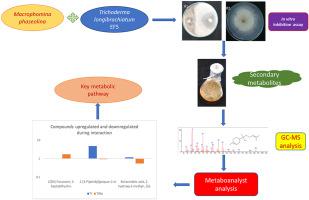Microbial Pathogenesis ( IF 3.8 ) Pub Date : 2020-12-28 , DOI: 10.1016/j.micpath.2020.104714 A P Sridharan 1 , Thangappan Sugitha 2 , G Karthikeyan 1 , S Nakkeeran 1 , Uthandi Sivakumar 2

|
An endophytic fungal antagonist Trichoderma longibrachiatum EF5 exhibited biocontrol activity against a soil-borne fungal pathogen Macrophomina phaseolina. Under dual co-culture, T. longibrachiatum EF5 showed 58% inhibition against M. phaseolina. Crude soluble metabolites (SMs) extracted from EF5 exhibited biocontrol activity (61%), which is more significant than the cell-free extract. Dual culture of both T. longibrachiatum EF5 and M. phaseolina displayed entangled mycelial structures and retarded hyphal growth. The metabolites responsible for antibiosis and pathogenic activity profiled through GC-MS revealed a total of 131 SMs from axenic culture and upon the interaction of T. longibrachiatum EF5 and M. phaseolina. Interestingly, potential plant-growth-promoting and antimicrobial compounds such as 1- pentanol, 1-hexanol, myristonyl pantothenate, bisabolol, d-Alanine, and diethyl trisulphide were unique with T. longibrachiatum EF5. Few compounds that were not observed or produced minimally under axenic culture were increased during their interaction (e.g., 1,6-anhydro-á-d-Glucopyranose and 5-heptyl dihydro-2(3H)-Furanone), suggesting antimicrobial action against the pathogen. This study also unraveled the induction of amino sugar metabolism when T. longibrachiatum EF5 interacts with M. phaseolina, which is responsible for colonization and counterfeiting the pathogen. Hence T. longibrachiatum EF5 could be a potential biocontrol agent employed for defense priming and plant growth promotion.
中文翻译:

的代谢物木霉EF5抑制土壤源性病原体,Macrophomina phaseolina通过触发氨基糖代谢
内生真菌拮抗剂长木霉EF5对土壤传播的真菌病原体菜豆( Phasephomina phaseolina)表现出生物防治活性。在双重共培养下,长臂烟草T. longibrachiatum EF5表现出对菜豆分枝杆菌的抑制率为58%。从EF5提取的粗制可溶代谢物(SMs)表现出生物防治活性(61%),这比无细胞提取物更为重要。T. longibrachiatum EF5和M. phaseolina的双重培养显示出纠缠的菌丝结构和延迟的菌丝生长。通过GC-MS分析的负责抗菌作用和致病活性的代谢物显示,总共有131种SM来源于无菌培养物,并且与T. longibrachiatum EF5和M.phaseolina。有趣的是,潜在的促进植物生长和抗菌的化合物,例如1-戊醇,1-己醇,肉豆蔻酸泛酸酯,bisabolol,d-丙氨酸和三硫酸二乙酯在长枝。草EF5中是独特的。很少有化合物在交互作用培养中未观察到或产生最少,例如在它们之间的相互作用中增加了(例如1,6-脱水-α- d-葡糖醛糖和5-庚基二氢-2(3H)-呋喃酮),表明对病原。这项研究还揭示了长支原木EF5与菜豆分枝杆菌相互作用时氨基糖代谢的诱导作用,负责定植和伪造病原体。因此,T。longibrachiatum EF5可能是用于防御启动和植物生长促进的潜在生物防治剂。


























 京公网安备 11010802027423号
京公网安备 11010802027423号